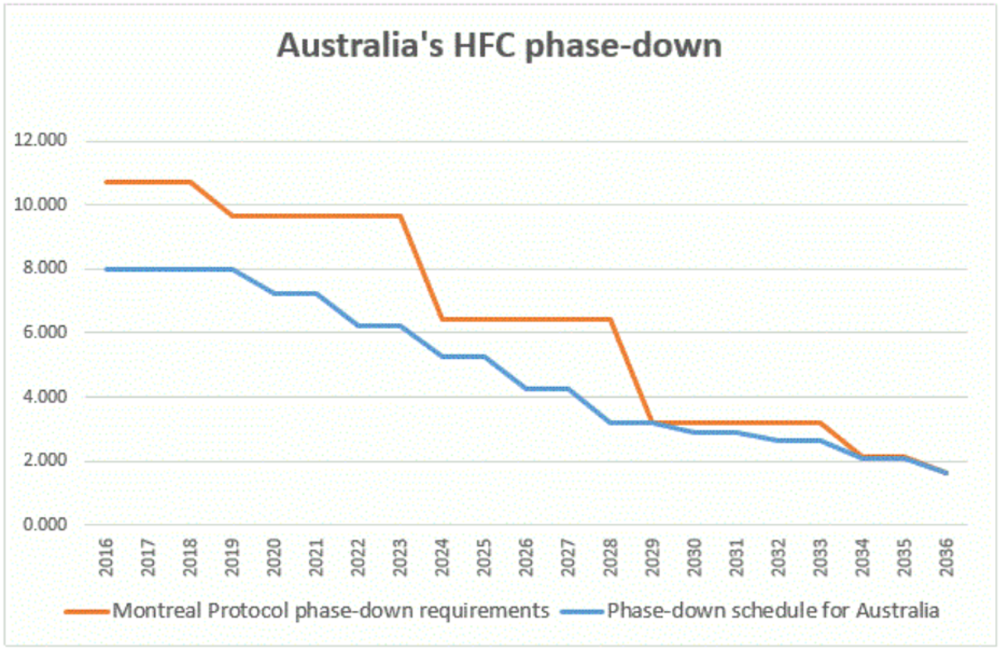The refrigerant market has been subject to significant changes over the past 40 years because of concern about the environmental impacts of refrigerants.
The Montreal Protocol (1987) initiated the phase out of CFC (chlorofluorocarbon) refrigerants such as R11 and R12 because of the massive damage these were doing to the ozone layer in the atmosphere.
The second phase of this phase out is drawing to a close currently, removing many of the refrigerants that were brought in to replace CFCs, being the HCFCs (hydrochlorofluorocarbons) such as R22 and R123. These chemicals, while of far lesser ozone depletion potential than the CFCs, still damage the ozone layer. Production of these refrigerants has essentially ceased, and it will become harder over the next few years to source replacement refrigerant for systems using these chemicals.
In 2016 the international community agreed to phase down the next group of refrigerants, being the HFCs (hydrofluorocarbons) such as R134a. These refrigerants have zero ozone depletion potential but unfortunately are significant contributors to global warming – one kg of R134a has the global warming potential of 1,430kg of CO2; a massive impact. The phase down is scheduled to occur between 2018 and 2036 by which Australia has committed to reduce its production and imports of bottled HFCs by 85% by 2036, as shown in Figure 3.
Figure 3. Australia’s HFC phase down schedule.
Source: www.environment.gov.au
While 2036 may seem a long way away, the fairly linear nature of the phase down means that refrigerant equipment being specified today is already at risk of a reduced lifespan due to the reduced availability and doubtless increased cost of HFC refrigerants in 10-15 years’ time: HFC imports and production will be over 60% lower in 2028 than in 2018.
It is one of the truisms of refrigeration that every phase of new refrigerants has been accompanied by a boost of innovation that expands the efficiency and applications of the technology in new and often not entirely expected ways. The current wave of new refrigerants in response to the phase down of HFCs – and the need to develop refrigerants with low global warming potential – has propelled CO2 into the fray as a major new refrigerant. CO2 has zero ozone depletion potential and, by definition, a global warming potential of 1.
The thermodynamic characteristics of CO2 make it particularly suitable for use in heat pump applications, operating at far higher temperatures than has been feasible with HFC heat pump technology. A second aspect of CO2 as a heat pump is that it works best where the heating process occurs over a large temperature range, such as is the case with domestic hot water, where water has to be heated from below 20°C to above 60°C. Converse this means that CO2 heat pumps are not a natural fit for conventional space heating hot water systems operating across a 20°C temperature difference, unless the water entering the heat pump is quite cool, i.e. 20-30°C.
In the final article in this series, CO2 Heat Pumps In Practice, we will look at the Revere CO2 heat pumps as an example of how these heat pumps perform and can be applied in practice.
This article series is kindly contributed by Dr Paul Bannister, a thought leader and public speaker on energy and energy efficiency issues in Australia. For other articles by Dr Paul Bannister, please refer to our news section.
Nerd Space: What’s so good about CO2 in heating?
The conventional refrigeration cycle operates between two phase-change processes: An evaporator in which liquid refrigerant evaporates, creating a cooling effect, and a condenser where gaseous refrigerant condenses, creating a heating effect. In each case what is transferred is known as latent heat. Just as water boils at a fixed temperature of 100degC and ice melts at a fixed temperature of 0°C – both phase change processes occur at fixed temperature. This characteristic is both useful and limiting, particularly if you want to generate very high condensing temperatures. CO2 has a particular property that at high (but achievable) pressures it enters a state known as “supercritical” which means that it no longer has a phase change between gas and liquid and thus has no fixed temperature latent heat transfer. This means that instead of transferring a large amount of heat at, say, 50°C, it transfers a comparable amount of heat, but across a wide range of temperatures from 90°C down to 10-20°C (and lower). This normal “sensible” heat transfer matches exactly the sort of heat transfer we want to achieve when heating water from cold to hot. As a result, supercritical CO2 pumps are perfectly matched to high temperature rise heating applications like domestic hot water.
Note that because the CO2 doesn’t condense when it transfers heat, the heat exchanger normally known as the condenser is called a gas cooler in CO2 heat pump systems.

